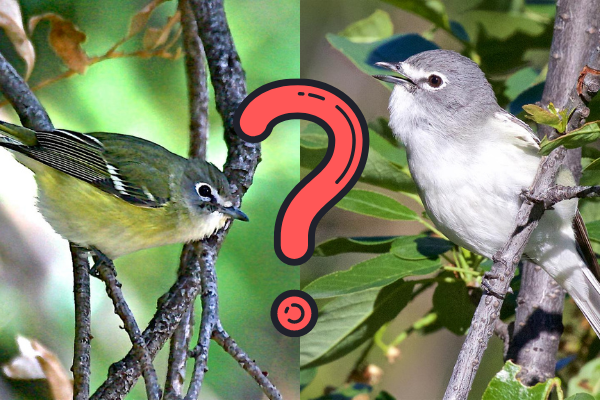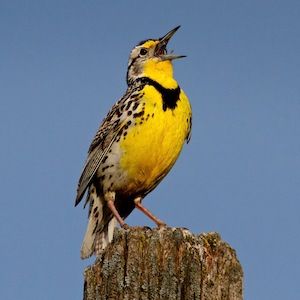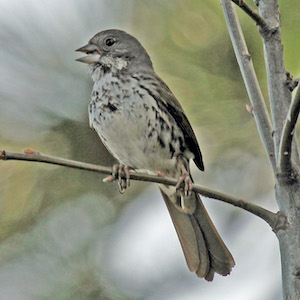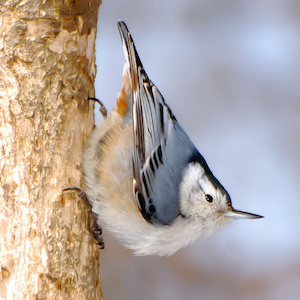IBP board member Ed Pandolfino is an accomplished birder who relies more on his ears than his eyes. "My hearing has always been very good, and my eyesight very poor (even WITH glasses)," says Pandolfino. "Also, birding by ear allows one to bird when doing other things. That means, to the consternation of my wife, I am 'never NOT birding.'"

It is well known that Cassin’s Vireo plumage in spring/summer can be quite worn and faded. Even in this excellent photo, taken at close range in perfect light, one can just make out a faint wash of yellow on the underparts. Seen under typical field conditions, this bird could appear to have no color at all. Photo by Ed Harper.
For Pandolfino, a microphone and a recorder are essential birding tools just like binoculars. He is a prolific recordist, and has contributed almost 500 recordings to the xeno-canto.org bird sounds database. But Pandolfino doesn't just listen to songs, he also carefully examines them visually using spectrograms- visual representations of sounds showing frequency over time. "Becoming familiar with looking at song on spectrograms changes the way one hears bird vocalizations and can really help one become a better ear birder," he notes, "It can give you a non-subjective way to describe and remember a sound."
Pandolfino is familiar with the distribution of bird species in California- he co-authored Birds of the Sierra Nevada: Their Natural History, Status, and Distribution along with Ted Beedy. So he noted reports of Plumbeous Vireos (Vireo plumbeous) in northeast California during the breeding season but was skeptical. Cassin's Vireos (Vireo cassinii) are more likely in that area and if their plumage is faded or worn they can appear quite pale and similar to Plumbeous. The available field guides and species accounts did not agree on whether or not Plumbeous Vireos breed in northeastern California. Some of the Plumbeous reports also noted that the birds were identified by song.
But can you really differentiate between Cassin's and Plumbeous Vireos by song? Field guides describe the two species' songs as very similar but some note that the Cassin's song is higher pitched with "clearer" phrases. But this seems fairly subjective, especially if you aren't hearing the songs side-by-side. Pandolfino turned to the scientific literature and found only two older studies that compared the songs quantitatively and these had very small sample sizes.
So Pandolfino teamed up with IBP research ecologist and statistical modeling pro Dr. Chris Ray to rigorously test whether song can indeed be used to differentiate between these two vireo species. Their study was recently published in Western Birds.
Pandolfino and Ray analyzed 32 high-quality song recordings from each species. Only recordings made within each species undisputed range were used to ensure that all birds were correctly identified. After creating spectrograms of the songs, they measured the following song characteristics to determine which best distinguished the species: phrase length, song rate (number of phrases per minute), proportion of phrases that included frequency modulation (“buzziness”), proportion of phrases that were doubled, and average frequency at the midpoint of each phrase. All characteristics except average midpoint frequency overlapped substantially between Cassin's and Plumbeous Vireos and were consequently not useful in distinguishing the species.
Statistical analysis showed that by choosing certain midpoint frequency cut-offs (with songs above the cutoff frequencies classified as Cassin's Vireos and those below as Plumbeous Vireos), one can correctly identify most birds to species with a high confidence level. However, the higher the confidence level, the more birds will fall into the “uncertain” intermediate frequency range. So will this help the birder in the field distinguish between a pale Cassin's and a Plumbeous by song? Pandolfino says no:
If you think you can tell Cassin’s from Plumbeous Vireos by song in the field, you are probably kidding yourself. It takes careful analysis of a good recording. And even then, many birds (about 16%) cannot be identified.
After all most people don't generate spectrograms in the field. And rarely do birds cooperate, with one species singing conveniently followed by the next so that one might compare their pitches in the wild. But Pandolfino and Ray's study will help scientists and birders interested in clarifying the actual breeding ranges of these two species in California and other areas where the ranges are unclear, such as some parts of Montana. It will also be useful in confirming or refuting reports of out-of-range Cassin's and Plumbeous Vireos. And it's always nice to settle an argument scientifically.
You can check out the spectrograms in video form of two songs used in the study below. Pandolfino notes:
These two songs are fairly representative of each species, with the pitch near the average we observed for each. While one can probably hear a difference in pitch when played back-to-back, making this discrimination in the field, given how much overlap we found among birds, is likely to be difficult to impossible.
Spectrogram of a Cassin's Vireo song recorded by Ed Pandolfino, 27 May, Placer County, CA, west slope of the Sierra Nevada.
Spectrogram of a Plumbeous Vireo song recorded by Nathan Pieplow, 16 June, La Plata County, CO.






